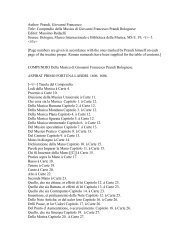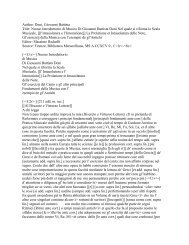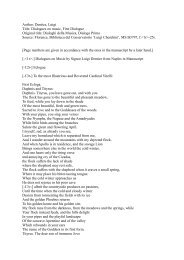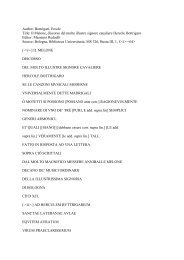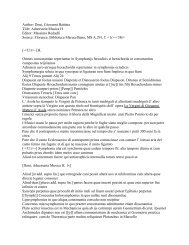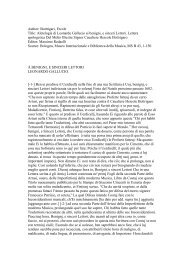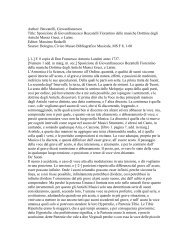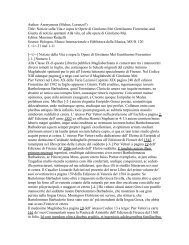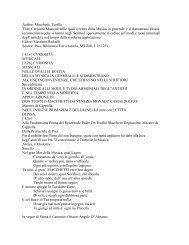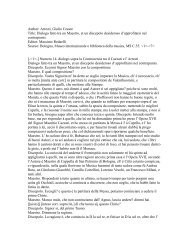Author: Doni, Giovanni Battista - manuscripts of italian music theory ...
Author: Doni, Giovanni Battista - manuscripts of italian music theory ...
Author: Doni, Giovanni Battista - manuscripts of italian music theory ...
Create successful ePaper yourself
Turn your PDF publications into a flip-book with our unique Google optimized e-Paper software.
than the thickening, because they show little concern for the melody that derives from<br />
it, as one can see from the multitude <strong>of</strong> diesis (which they use), since, consequently, it<br />
is not possible for anyone to sing them, but the voice can sing up to three <strong>of</strong> them.<br />
One can see from this that there were some who dealt with these divisions without<br />
considering whether they were viable or not. But let us move on to Aristides<br />
Quintilianus, a most learned and elegant writer, who did not deserve to remain hidden<br />
for such a long time in libraries. As one can see, he compiles a summary and a short<br />
explanation [--] <strong>of</strong> all <strong>music</strong> with the help <strong>of</strong> Aristoxenus' works which were<br />
available at the time, since he lived certainly before the fall <strong>of</strong> the Roman Empire.<br />
Therefore, he says this [Harmonia men oun kaleitai to tous smikrotatois pleounasan<br />
diastemasin apo tou synermoustai; diatonon de to tonois pleonazon epeide sfodroteron<br />
he phone kat'auto diateinetai khroma de to di’hemitonion syntononomenon hos gar to<br />
metaxu leukou hos melanos chroma kaleitai; outo kai to dia meson amphoin<br />
theorgmenon chroma proseretai [[technokoteron]]], which means “So, Harmony<br />
(which means the Enharmonic genus, which was call this without any other<br />
specification) is called (that genus) which is most rich <strong>of</strong> very small intervals from<br />
their being tuned together (which the Greeks call harmozesthai). However, the<br />
Diatone (or Diatonic) is the one that is rich in Tones, because the voice is extended<br />
more strongly in this genus (he means that the word [tonos] derives from teinesthai),<br />
but the Chroma (namely, the Chromatic one) which means colour or colouring, and<br />
here it means the chromatic genus, is the one that extends itself (or rises) through<br />
semitones, since what is halfway between white and black is called colour, thus it has<br />
been called chromatic the one that is considered halfway between the two mentionead<br />
above.” The follower <strong>of</strong> Plato Theon does not depart much from this when he says, on<br />
Aristoxenus' authority, that the Diatonic is called thus [hetoi hoti dia ton tonon to<br />
pleiston diodeuse e hoti semnon ti kai erromenon hai eutonon ethos epifainei] which<br />
means “because it mostly proceeds by tones or because it shows something which is<br />
grave, robust and intense.” [chromatikon de dia to paratetraphthai kai exellachtai tou<br />
prosthen; goeroteron kai pathetikoteron ethos emphainei] “But the Chromatic, which<br />
is different and other than the first one, shows a more pathetic and plangent quality.”<br />
Finally, the Harmony or Enharmonic genus was called in this way [dia to arista einai<br />
apenenkamenon tou pantos hermosmenou ten prosegorian] “because it derived its<br />
name from the entire System <strong>of</strong> sounds, since it enacted what they called the<br />
[hermosmenon]). [--] As far as Manuel Briennius is concerned, one has not to<br />
give it much consideration, as far as his reporting <strong>of</strong> ancient matters is concerned<br />
(although one has to value his speculations and all his work where he shows that he<br />
understood Ptolemy and the others well) because he is a modern author, and does<br />
almost nothing else but copying Aristides, without considering <strong>Author</strong>s whom we do<br />
not possess, albeit his speculations have to be valued and all the work that he has<br />
written in three books, because it clarifies greatly the most ancients, and particularly<br />
Ptolemy whom he shows to have understood well. Therefore, it will suffice <br />
that he agrees with Aristides and with others in his description <strong>of</strong> the genera, and to<br />
explain the smaller intervals <strong>of</strong> the Chromatic and Enharmonic. As to Nichomacus <strong>of</strong><br />
Gerace, a very able mathematician, whose very beautiful work on arithmetic is<br />
available in print and two books <strong>of</strong> Harmonics, albeit incomplete, and was followed<br />
closely by Boethius, it will be enough to quote this, where he says [to de euarmonion<br />
tou procopen physikos toiauten ekhei diesis; hoper esti hemitoniou hemisu kai palin<br />
alle diesis, syamphoterai hemitonio isai.hemitoniou emisou kai palin alle diesis,<br />
sunakfoteroi hemitono isan]



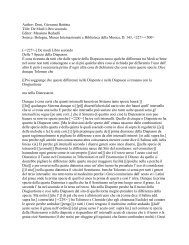
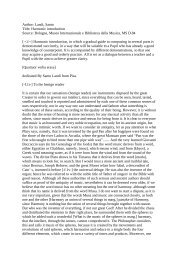
![Doni, Giovanni Battista Title: Trattato Dei Tuoni o [[Harmonie de]]](https://img.yumpu.com/45461005/1/190x245/doni-giovanni-battista-title-trattato-dei-tuoni-o-harmonie-de.jpg?quality=85)
